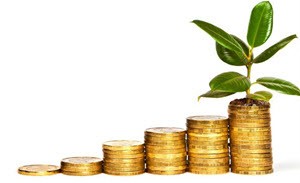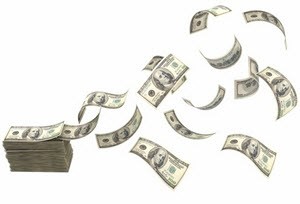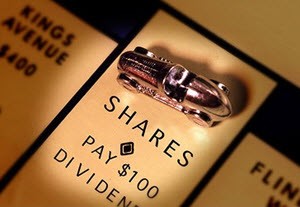Stock dividends
 When a stock company makes a profit, it can elect to distribute some of that profit to its owners, i.e. to the shareholders, in the form of a stock dividend. In theory it would be possible for a company to distribute its entire profit this way, but this is highly unusual.
When a stock company makes a profit, it can elect to distribute some of that profit to its owners, i.e. to the shareholders, in the form of a stock dividend. In theory it would be possible for a company to distribute its entire profit this way, but this is highly unusual.
It should be noted that the profit that is handed out in the form of dividends doesn’t have to be a newly made profit – it can just as well be some money or any other asset that the company has saved from earlier years and that it now has decided to divide among its shareholders.
Dividends can be payed out in many different forms, including cash and shares of stock.
Why invest in companies known to pay dividends
Many investors like to purchase shares in companies that have a long history of paying stable or rising dividends, and there are several good reasons to do so.
- In quite a few jurisdictions, income from dividends are favorably treated when it comes to taxation. In such jurisdictions, having a cash flow comprised of dividends can be highly advantageous compared to other types of more heavily taxed cash flows. Also, investors in high marginal tax brackets can benefit greatly from being able to receive money without being bumped up into an even higher tax bracket.
- If a company has a long history of paying stable or rising dividends, that company is probably a well-established company that is making a profit even in harsh economic circumstances.
- If you invest in stocks that doesn’t pay dividends, you are not actually making any money from your stocks until you sell them (unless you use advanced financial instruments), even if the company is doing great while you own shares in it.Example: You purchase 1 share for $10, and it increases up to $50 and stays in that area for several years. You are happy that your share has increased in value. However, before you get around to selling it, the value drops down to $9.If that share had given you a dividend of $3 a year for five years before dropping down to a price of $9 you would have made a profit from your investment even though the value of the share itself is now just $9.
Special dividends
Public companies that pay out dividends will normally have a fixed schedule for these payments. It is however possible for a company to pay out dividends outside this fixed schedule, a so called special dividend. The reasons behind special dividends vary, but they are for instance known to take place when a company has made significant changes to its debt ratio. A company that has achieved especially high earnings during a period of time, but that suspects that those high earnings will not be sustained, can also elect to do a special dividends payout rather than changed the fixed schedule payouts.
 Dividend payout policies
Dividend payout policies
Before you invest in a company, it is a good idea to check out their dividend payout policy. The three most common polices are the Constant Payout, the Stable Dividend and the Residual Dividend.
With a Constant Payout Policy, the company will pay a predetermined percentage of its profit in dividends each year. A company with a Stable Payout Policy will on the other hand aim to pay a predetermined sum in dividends each year, regardless of the exact size of the profits. With a Residual Dividend Policy, the company will retain a part of the profit to finance the equity portion of its capital budget. The residual amount is then paid out in the form of dividends.
I want to invest in shares that will give me dividends
Even if a company has a history of paying dividends to its shareholders, there is no way of guaranteeing that it will continue to do so in the future. The company may for instance fall into financial problems or decide to use its profits for expansion or R&D rather than pay dividends.
With that said, companies with a long history of of paying stable or rising dividends is still your best bet if it’s dividends your after. Examples of sectors where such companies are common are basic materials, utilities, oil and gas, bank and financial, healthcare and pharmaceuticals, and real estate.
Here are a few examples of companies that paid comparatively large dividends to their shareholders in early 2015:
 Phillips 66 Partners LP (PSXP)
Phillips 66 Partners LP (PSXP)- General Electric Co. (GE)
- Honeywell International, Inc. (HON)
- Procter & Gamble Co. (PG)
- Ladbrokes (LAD)
- Antofagasta (ANTO)
- Berkeley Group (BKG)
- WM Morrison Supermarkets (MRW)
- Vedanta Resources (VED)
- Balfour Beatty (BBY)
- J Sainsbury (SBRY)
- Serco Group (SRP)
- Phoenix Group (PHNX)
- Centrica (CNA)
- Premier Farnell (PFL)
- Petrofac (PFC)
- Ashmore Group (ASHM)
- BP (BP.)
- Infinis Energy (INFI)
- Friends Life (FLG)
What is a dividend reinvestment program?
A dividend reinvestment program (DRIP) is a program offered by the company that issues the dividends to its shareholders. If you chose to enter the program, your dividend will be directly reinvested in the underlying equity and you will not receive any cash payment.
There are brokers that offer “synthetic” DRIP:s for their customers. So, if you receive a cash dividend from Company A, and have entered into your brokers DRIP, your broker will automatically reinvest your dividend money into Company A equity for you. Using a synthetic drip is usually much more cost-effective for the customer than first receiving the cash dividend and then place a regular purchase order for equity in Company A.
This article was last updated on: May 6, 2015